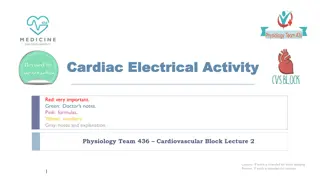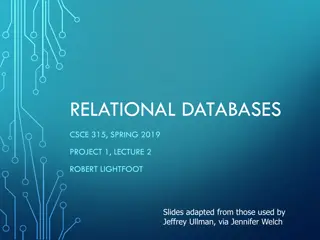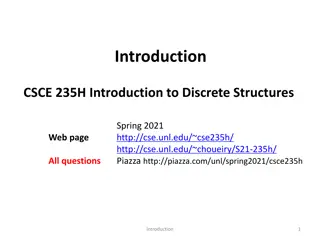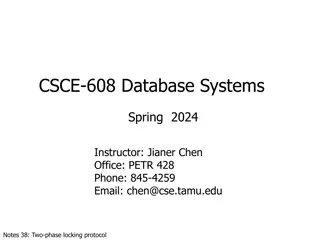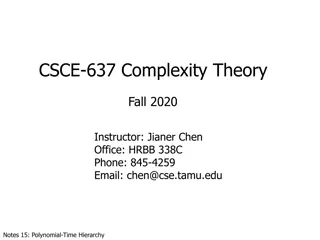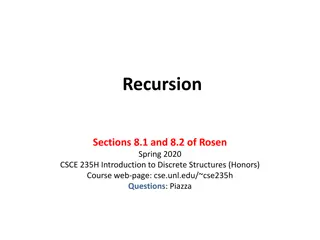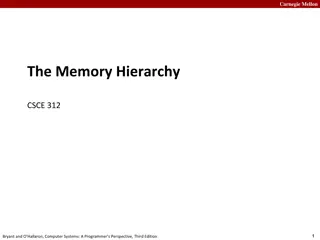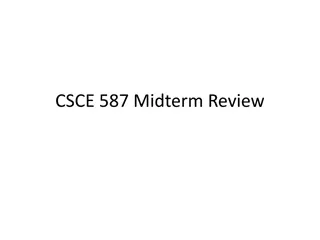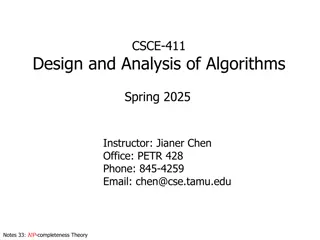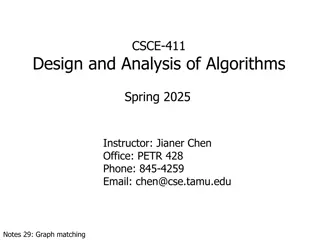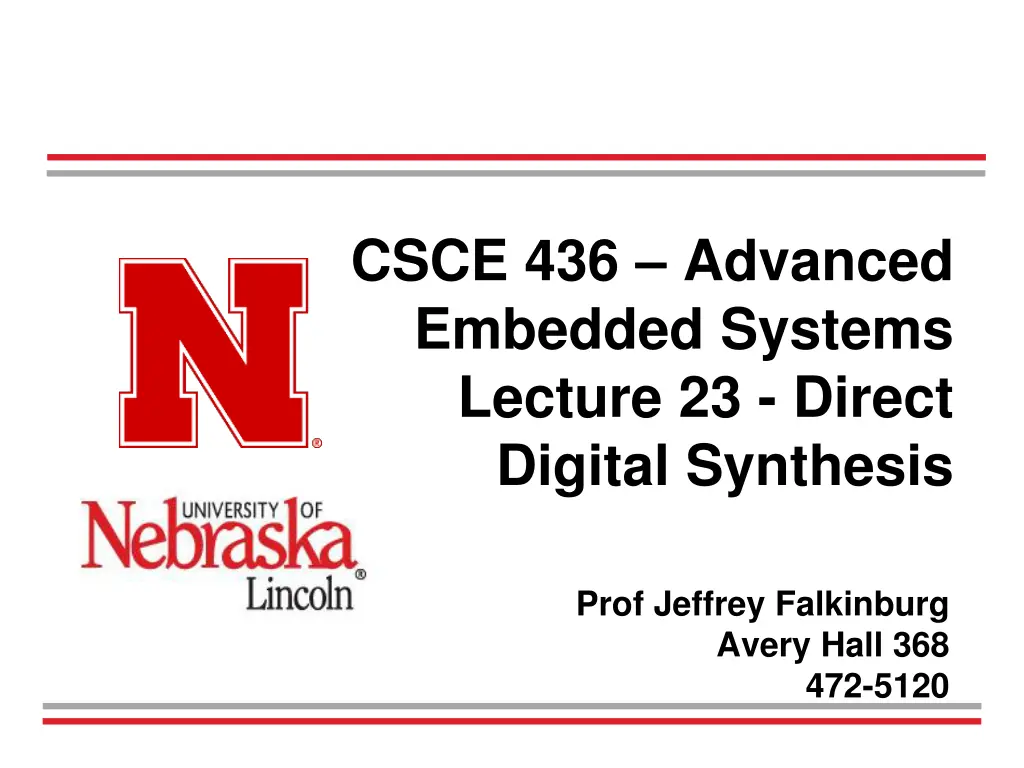
Embedded Systems Lecture on Fixed Point Arithmetic and Binary Numbers
Explore the concepts of fixed point arithmetic and binary numbers in this advanced embedded systems lecture. Learn how to convert binary to decimal values and understand the representation of numbers to the right of the binary point. Discover techniques for converting numbers like 1.53125 into binary form and grasp the significance of different bit positions in binary-coded numbers. Dive into practical examples and insights to enhance your understanding of direct digital synthesis and number systems.
Download Presentation

Please find below an Image/Link to download the presentation.
The content on the website is provided AS IS for your information and personal use only. It may not be sold, licensed, or shared on other websites without obtaining consent from the author. If you encounter any issues during the download, it is possible that the publisher has removed the file from their server.
You are allowed to download the files provided on this website for personal or commercial use, subject to the condition that they are used lawfully. All files are the property of their respective owners.
The content on the website is provided AS IS for your information and personal use only. It may not be sold, licensed, or shared on other websites without obtaining consent from the author.
E N D
Presentation Transcript
CSCE 436 Advanced Embedded Systems Lecture 23 - Direct Digital Synthesis Prof Jeffrey Falkinburg Avery Hall 368 472-5120
Lesson Outline Time Logs! Lab 3 O Scope Control Functionality Due COB Today Write-up Due COB LSN 26 Project Proposals Due BOC LSN 27 Fixed Point Arithmetic and Multiplication Direct Digital Synthesis Phase Increment 2 CSCE 436 Advanced Embedded Systems
Fixed Point 3 CSCE 436 Advanced Embedded Systems
Fixed Point Binary Coded Number: 10010 How do you (formally) determine what decimal value it represents? You need the Equation: Decimal value = sum(bi*2i) Where the sum ranges over all the bit positions i. Remember that the LSB (the one closest to the binary point) is ALWAYS index 0. 1*24+ 0*23+ 0*22+ 1*21+ 0*20= 16 + 2 = 18 4 CSCE 436 Advanced Embedded Systems
Fixed Point Well now generalize this idea to the right of the binary point and take a stab at what 1.11 means? Important to note is that to represent values less than 1 (to the right of the decimal point), negative indices need to be used 1*20+ 1*2-1+ 1*2-2= 1 + 0.5 + 0.25 = 1.75 5 CSCE 436 Advanced Embedded Systems
Fixed Point Lets now convert 1.53125 into binary. This is done by using the tried and true technique of finding the largest power of 2 that will fit into the number, subtracting it, and then continuing the conversion with the difference. This process stops when you get down to zero. To illustrate: The largest power of two that fits into 1.53125 is 20= 1.0 The largest power of two that fits into 0.53125 is 2-1= 0.5 The largest power of two that fits into 0.03125 is 2-5= 0.03125 Thus the binary representation of 1.53125 is 1.10001 6 CSCE 436 Advanced Embedded Systems
Fixed Point Number Systems Given: 01010.0101 (Designated in Q5.4 Format) Find Decimal value: 1*23+ 1*21+ 1*2-2 + 1*2-4 = 8 + 2 + 0.25 + 0.0625 = 10.3125 7 CSCE 436 Advanced Embedded Systems
Fixed Point Number Systems Lets now convert -13.3125 into binary (Q8.8 Format) Forget about the negative for now The largest power of two that fits into 13.3125 is 23= 8 The largest power of two that fits into 5.3125 is 22= 4 The largest power of two that fits into 1.3125 is 21= 1 The largest power of two that fits into 0.3125 is 2-2= 0.25 The largest power of two that fits into 0.0625 is 2-4= 0.0625 Thus the binary representation of 13.3125 is 00001101.01010000 Now how to make it a negative 2 s Complement? Flip bits and add 1 to LSB 00001101.01010000 11110010.10110000 0xF2B0 -13.3125 8 CSCE 436 Advanced Embedded Systems
Fixed Point Remember 13.3125 in binary (Q8.8 Format) is 00001101.01010000 What if that binary number was in Q16.0 Format what would you get? All you have to do is shift the binary point right by 8-bits 00001101 01010000. Converted to decimal is 340810 You get this by multiplying 13.3125 * 28 = 3408 to shift the binary point right by 8 bits Works in Reverse as well: 3408 / 28 = 13.3125 Alternatively 3408 * 2-8 = 13.3125 9 CSCE 436 Advanced Embedded Systems
Fixed Point As you can imagine, some rational real numbers do not have a rational binary representation. For example, the decimal number 0.1 cannot be represented as a finite binary string of 0's and 1's - it would repeat endlessly. You can give the conversion a try if you want to prove this yourself. 10 CSCE 436 Advanced Embedded Systems
Fixed Point Arithmetic 11 CSCE 436 Advanced Embedded Systems
Fixed Point Arithmetic Fixed point numbers vs floating point? Can represent numbers with fractions even when hardware resources are limited or you would like to keep complexity to a minimum. 12 CSCE 436 Advanced Embedded Systems
Fixed Point Arithmetic W7 W6 W5 W4 W3 W2 W1 W0 . F7 F6 F5 F4 F3 F2 F1 F0 The 8 W-bits represent the whole portion The 8 F-bits represent the fractional portion The resulting 16-bit number can be manipulated as a whole with some minor book keeping to keep track of the binary point This is Q8.8 format 13 CSCE 436 Advanced Embedded Systems
Fixed Point Arithmetic As an exercise determine the representation of: 23.5 and 45.25 in Q8.8 format and then add them. 00010111 10000000 (23.5) + 00101101 01000000 (45.25) --------------------------------------- 01000100 11000000 (68.75) What about the Binary Point? Doesn t really exist per se Line up binary points and add the bits like normal binary addition 14 CSCE 436 Advanced Embedded Systems
Fixed Point Multiplication 15 CSCE 436 Advanced Embedded Systems
Fixed Point Multiplication Assume that 23 have a 4-bit representation where the binary point resides in the middle of the number (i.e. Q2.2). We will multiply 3.25 and 1.25. 1111 (3.75) Multiplicand x 0101 (1.25) Multiplier -------------------- 1111 0000 1111 + 0000 --------------------- ----------- 0100.1011 (4.6875) Product requires (Q4.4) 16 CSCE 436 Advanced Embedded Systems
Fixed Point Multiplication What if the multiplier is the wrong size? Lets consider the multiplication of two 16-bit fixed point numbers (representing angles) WA:FA and WB:FB. From our discussion the product requires 32-bits to represent. 17 CSCE 436 Advanced Embedded Systems
Direct Digital Synthesis 18 CSCE 436 Advanced Embedded Systems
Direct Digital Synthesis Direct Digital Synthesis (DDS) is a technique to create periodic waveforms with very precise frequency control using a system with a fixed clock frequency. The periodic function is stored in a look-up table like the following for a sin wave. int8 sin[64] = {128,141,153,165,177,189,200,210,219,227,235,241,246,250,253,255, 255,254,252,248,244,238,231,223,214,205,194,183,171,159,147,134, 122,109, 97, 85, 73, 62, 51, 42, 33, 25, 18, 12, 8, 4, 2, 1, 1, 3, 6, 10, 15, 21, 29, 37, 46, 56, 67, 79, 91,103,115,128}; 19 CSCE 436 Advanced Embedded Systems
Direct Digital Synthesis int8 sin[64] = {128,141,153,165,177,189,200,210,219,227,235,241,246,250,253,255, 255,254,252,248,244,238,231,223,214,205,194,183,171,159,147,134, 122,109, 97, 85, 73, 62, 51, 42, 33, 25, 18, 12, 8, 4, 2, 1, 1, 3, 6, 10, 15, 21, 29, 37, 46, 56, 67, 79, 91,103,115,128}; Table Length is a factor of 2^n (i.e. 2^6 = 64 samples). 20 CSCE 436 Advanced Embedded Systems
Phase Increment 21 CSCE 436 Advanced Embedded Systems
Phase Increment Lets say that you could provide a new sample from the sin table at 48kHz (through an interrupt) to the codec. If you incremented the pointer in the sin table by 1 on every interrupt. How long to get through the table? 64*21uS = 1.3mS Generating a sine wave with a frequency of about 750Hz If you incremented the pointer in the sin table by 2 every interrupt. How long to get through the table? 32*21uS = 0.65mS Generating one period of the sine wave for a frequency of about 1.5kHz. 22 CSCE 436 Advanced Embedded Systems
Phase Increment Using integer values for the increment we are limited to very coarse adjustments in the frequency. For example how could you use this schema to generate a sin wave with frequency of 1.0kHz? Well you would need to increment the pointer in the sin table by 1.5 every 21uS. And surprisingly, you can easily accomplish this using a fixed point representation. This fractional value is called the phase increment. 23 CSCE 436 Advanced Embedded Systems
Phase Increment Lets look at how the phase increment, update rate, and size of the LUT are related to the output frequency. 1) Given a lookup table with 2^N values corresponding to one wavelength of a function. 2) Given a sampling rate or a play back rate of fs updates/second 3) Given a phase increment x, which every 1/f is added to the index of the LUT. fs updates x values -------------- * -------------- * ------------- = ---- hz 1 second update 1 cycle f*x 2^N values 2^N 24 CSCE 436 Advanced Embedded Systems
Questions 25 CSCE 436 Advanced Embedded Systems
Questions Assuming an update rate of 48kHz, a LUT with 1024 entries, and a phase increment of x, expressed as a 10.6 fixed point number. Answer the following questions. What is the maximum frequency we could generate? What is the minimum frequency we can generate? What is the smallest change in frequency we can make with the phase increment? What phase increment generates a frequency of 440hz? How did I arrive at the format of the phase increment? 26 CSCE 436 Advanced Embedded Systems
Phase Increment Given: Fs = 48 KHz 2N = 1024 Find x to generate 440 Hz as a 10.6 fixed point number? fs updates x values -------------- * -------------- * ------------- = ---- hz 1 second update What phase increment generates a frequency of 440hz? 1 cycle f*x 2^N values 2^N ? 2?= 46.875 46.875? = 440?? ? = 9.387 ? = 0000 0010 01.01 1001 27 CSCE 436 Advanced Embedded Systems
Phase Increment Given: Fs = 48 KHz 2N = 1024 What is the maximum frequency we could generate assuming Q10.6? fs updates x values -------------- * -------------- * ------------- = ---- hz 1 second update What is the maximum frequency we could generate? Why can t we use ? = 512? Because of Nyquist Theorem Why can t we use ? = 512? Because of Nyquist Theorem 1 cycle f*x 2^N values 2^N ? 2?= 46.875 Largest ? = 256 ?.?.0100 0000 00.00 0000 46.875 x = 12??? 28 CSCE 436 Advanced Embedded Systems
Phase Increment Nyquist Theorem states that we must sample a signal at twice the highest frequency. ? = 512 would give us the highest frequency, but the problem is Why can t we use ? = 512? Because of Nyquist Theorem 29 CSCE 436 Advanced Embedded Systems 1024 Samples
Phase Increment Given: Fs = 48 KHz 2N = 1024 What is the minimum frequency we could generate assuming Q10.6? fs updates x values -------------- * -------------- * ------------- = ---- hz 1 second update What is the minimum frequency we can generate? 1 cycle f*x 2^N values 2^N ? 2?= 46.875 Smallest ? = 2 6?.?.0000 0000 00.00 0001 46.875 0.015625 = 0.73?? 30 CSCE 436 Advanced Embedded Systems
Phase Increment Given: Fs = 48 KHz 2N = 1024 What is the smallest change in frequency we can make with the phase increment? fs updates x values -------------- * -------------- * ------------- = ---- hz 1 second update What is the smallest change in frequency we can make with the phase increment? Smallest change ? = 2 6?.?.0000 0000 00.00 0001 46.875 0.015625 = 0.73?? 1 cycle f*x 2^N values 2^N 31 CSCE 436 Advanced Embedded Systems
Phase Increment Given: Fs = 48 KHz 2N = 1024 How did I arrive at the format of the phase increment? fs updates x values -------------- * -------------- * ------------- = ---- hz 1 second update How did I arrive at the format of the phase increment? The RAM needs a 10-bit address. A standard 16-Bit register would have 6 bits left over for the fraction. 1 cycle f*x 2^N values 2^N 32 CSCE 436 Advanced Embedded Systems


